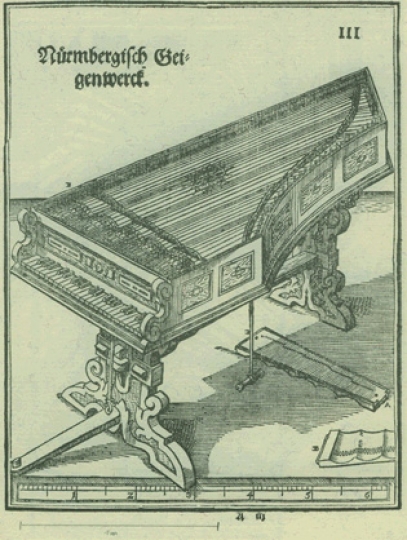Bowed strings
The „Nürmbergisch Geigenwerck“ by Hans Hayden
Plate III in Michael Praetorius, Theatrum Instrumentorum, Wolfenbüttel 1620 (illustrated appendix of his Syntagma Musicum II. De Organographia, Wolfenbüttel 1619).
The maybe most famous of all bowed keyboard instruments was Hans Hayden's „Geigenwerck,“ described in detail by Praetorius. However, no instrument survived.
Keyboard instruments with bowed strings are an age-old dream of instrument makers.
Leonardo da Vinci already designed a mechanism for such an instrument („Viola organista“), and the first working instrument, the „Nürmbergisch(e) Geigenwerck“ or „GeigenClavicymbel“ by Hans Hayden (a1610) was praised and admired by contemporaries. But only a fanciful copy by the Spaniard Fray
Raymundo Truchado (today in Brussels) survived.
Century after century (at times just year after year) one new invention followed another. A few works were composed like by Carl Philipp Emanuel Bach (Sonate fürs Bogenclavier 1783; Wq 65-48/H 280 1783) for the „Bogenklavier“ by Holfeld in Berlin or Carl Maria von Weber (Adagio und Rondo mit Orchester; 1811) for the „Harmonichord“ by Kaufmann in Dresden; but none of these inventions were particularly successful.
The basic construction was based on either rosined wheels in rotation, familiar from the hurdy-gurdy, or an endless ribbon of horsehair or fabric, or in the shape of a "borrowed" violin bow („Claviola“); some constructions used Chladni's invention of "indirect bowing" he had developed for his "Euphon" (not the string itself but a solid object firmly linked to it, like a metal thread, is bowed, thereby transmitting the vibration to the string). The basic problem remained unsolved though: How to get a single string vibrating without moving the string to the bow (and deteriorate its pitch) or the bowing mechanism towards the string (and possibly touch several strings at once like with the wheel, or to tear the hair like with the horse hair ribbon, or to get just some slow and stuttering response as with indirect bowing following Chladni).
So even after more than five centuries no sufficiently working bowed keyboard has been invented yet, despite all repeated attempts. The dream of a "string orchestra for piano players" is still on wait, but in the times of digital sampling any urgency might have somewhat diminished.
© Greifenberger Institut für Musikinstrumentenkunde | info@greifenberger-institut.de




